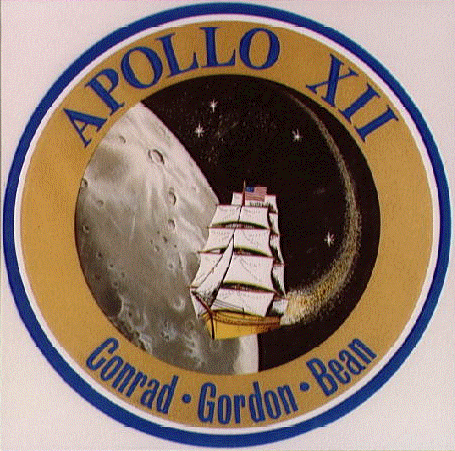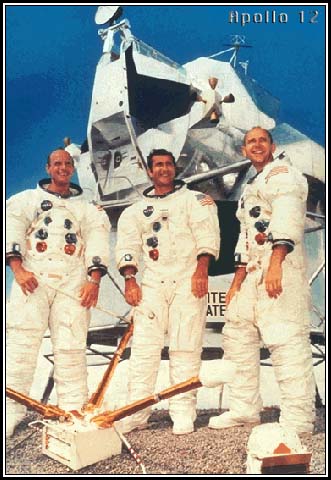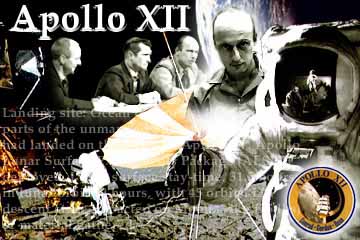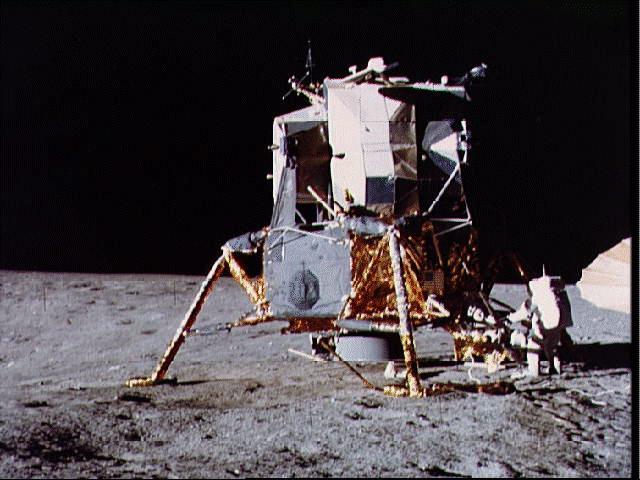
|
||||||||||||
|
|
|
Apollo 12
Launched: 14 November
1969 UT 16:22:00 (11:22:00 a.m. EST)
Charles Conrad, Jr., commander
Apollo 12 was the second mission in which humans walked on the lunar surface and returned to Earth. On 19 November 1969 two astronauts (Apollo 12 Commander Charles P. "Pete" Conrad and LM Pilot Alan L. Bean) landed in Oceanus Procellarum (Ocean of Storms) on the Moon in the Lunar Module (LM) while the Command and Service Module (CSM) (with CM pilot Richard F. Gordon) continued in lunar orbit. During their stay on the Moon, the astronauts set up scientific experiments, took photographs, examined the nearby Surveyor 3 spacecraft which had landed on the Moon 2 1/2 years earlier and removed pieces for later examination on Earth, and collected lunar samples on two moonwalk EVA's. The LM took off from the Moon on 20 November and the astronauts returned to Earth on 24 November. Mission Profile Launch took place under cloudy, rain-swept skies on Saturn V SA-507 on 14 November 1969 at 16:22:00 UT (11:22:00 a.m. EST) from Pad 39A at Kennedy Space Center. The spacecraft was struck by lightning 36 seconds after launch and again 52 seconds after launch, which momentarily shut off electrical power and cut out telemetry contact. Power was automatically switched to battery backup while the crew resored the primary power system. There were no further problems with the power system and the spacecraft entered planned Earth parking orbit at 11 minutes 44 seconds after liftoff. After 1 1/2 orbits the S-IVB stage was re-ignited at 19:15:14 UT for a translunar injection burn of 5 min. 45 sec. putting the spacecraft on course for the Moon. The CSM separated from the S-IVB stage containing the LM 25 minutes later, turned around and docked with the LM at 19:48:53 UT. The S-IVB stage was then jettisoned into Earth orbit instead of planned heliocentric orbit due to error in the instrument unit. During lunar coast, the LM was checked out to ensure no electrical damage had been caused by the lightning. A midcourse correction was made on 16 November at 02:15 UT. A six minute SPS burn on 18 November at 03:47:23 UT put the Apollo 12 into lunar orbit. Two orbits later a second burn circularized the orbit. Conrad and Bean entered the LM and it separated from the CSM at 04:16:03 UT on 19 November. The LM descent engine fired for 29 seconds at 05:47 UT, and the LM landed in Oceanus Procellarum near the rim of Surveyor crater at 06:54:35 UT. Conrad and Bean performed two surface EVA's, one on 19 November and one on 20 November, during which an Apollo lunar surface experiments package (ALSEP) was placed on the lunar surface, 34.4 kg of samples of the lunar terrain were acquired, various photographs were exposed by the astronauts during lunar surface activities, and parts were taken from the Surveyor 3 spacecraft for examination.
Astronaut Alan L. Bean, lunar module pilot for the Apollo 12 lunar landing mission, works at the Modular Equipment Stowage Assembly (MESA) on the Apollo 12 Lunar Module during the mission's first extravehicular activity, EVA 1, on November 19, 1969 The LM lifted off from the Moon on 20 November at 14:25:47 UT after 31 hours 31 minutes on the lunar surface. After docking with the CSM at 17:58:22 UT, the LM was jettisoned at 20:21:30 and intentionally crashed into the Moon creating the first recorded artificial moonquake. Transearth injection began at 20:49:16 UT on 21 November with a firing of the CSM main engine. A mid-course correction was made on 22 November. The CM separated from the SM on 24 November at 20:29:21. Apollo 12 splashed down in the Pacific Ocean on 24 November 1969 at 20:58:24 UT (3:58:24 p.m. EST) after a mission elapsed time of 244 hrs, 36 mins, 24 secs. The splashdown point was 15 deg 47 min S, 165 deg 9 min W, near American Samoa and 6.9 km (4.3 mi) from the recovery ship USS Hornet. Performance of the spacecraft, the first of the Apollo H-series missions, was very good for all aspects of the mission. The primary mission goals of an extensive series of lunar exploration tasks, deployment of the ALSEP, and demonstration of the ability to remain and work on the surface of the Moon for an extended period were achieved. Conrad was a Navy Commander on his third spaceflight (previously on Gemini's 5 and 11, later to fly on Skylab 2), Bean was a Navy Lt. Commander on his first flight (he later flew on Skylab 3), and Gordon was a Navy Commander on his second flight (Gemini 11). The backup crew for this mission was David Scott, Alfred Worden, and James Irwin. The Apollo 12 Command Module "Yankee Clipper" is on display at the Virginia Air and Space Center in Hampton, Virginia. The returned Surveyor 3 camera is on display at the Smithsonian Air and Space Museum in Washington, D.C. |





